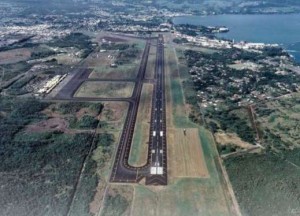Hawaiʻi Airports Upgrading to LED Lights, Solar Systems
The Hawaiʻi Department of Transportation (HDOT) has initiated the second phase of an energy savings initiative that will save more than $606 million in energy costs at Hawaiʻi’s airports over a 15-year period.
Phase 2 of HDOT’s Energy Savings Performance Contract with Johnson Controls (JCI) will provide high-efficiency lighting at 11 Hawaiʻi airports on Maui, Oʻahu, Kauai and Hawaiʻi Island. Nearly 50,000 existing florescent light bulbs will be replaced by Light Emitting Diode (LED) lamps and fixtures, providing an estimated $65.5 million in energy savings.
The initiative will also provide over 15,000 photovoltaic, roof-mounted solar panels at Honolulu International Airport capable of generating 5.3 megawatts of power.
“Installing photovoltaic to help meet the energy needs at the state’s largest airport makes sense,” said Ford Fuchigami, Hawaiʻi Department of Transportation director. “We are continuing to transform our transportation infrastructure to advance the state’s sustainability and energy efficiency goals.”
The HDOT initiative aligns with Gov. David Ige’s Hawaiʻi Clean Energy Initiative sustainability goals, and will reduce energy usage at state airports by nearly 63 million kilowatt hours per year over 15 years. The energy savings could power more than 175,000 homes in Hawaiʻi.
“This initiative’s unprecedented energy and cost savings confirms that going green is good for our local economy,” said Gov. Ige. “The cost-effective investments are cutting energy demand and increasing efficiency, which contributes to the reduction of the state’s dependence on fossil fuels. This is an important part of reaching our long-term energy sustainability goals.”
Phase 2 is scheduled to happen over the next two years and will be paid for through realized energy savings rather than taxpayer money. The construction will not affect flight schedules.
JCI is also working to improve the efficiency of highways and harbors under HDOT. The total amount of guaranteed energy savings for airports, highways and harbors projects is more than $776 million over the life of the Energy Savings Performance Contracts.
The Department of Business, Economic Development, and Tourism (DBEDT) estimates that over the life of the contract, which ends in 2034, the economic impacts will be $27.3 million in tax revenues, $186.6 million in income to households and 867 jobs created or supported each year during the first two years of construction. The dollar amounts are measured in 2016 U.S. currency values.
The contract also supports Hawaiʻi’s commitment to the Performance Contracting Accelerator Program, part of the U.S. Department of Energy’s Better Buildings Initiative. Performance contracting uses guaranteed energy savings generated by energy and water efficiency projects to pay for the projects. As a result, agencies can fund and install energy efficiency retrofits in a timely manner, cutting implementation times by 50 percent or more.















